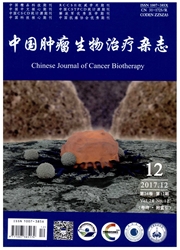

 中文摘要:
中文摘要:
目的:通过体外、体内实验探讨肿瘤细胞柯萨奇腺病毒受体(coxsackie adenovirus receptor,CAR)表达水平与腺病毒转导效率的关系,为腺病毒相关的生物制剂在临床个体化应用提供实验依据。方法:将载有绿色荧光蛋白的Ad5型腺病毒(Ad.GFP)以100MOI、200MOI分别感染人食管癌细胞系KYSE510、KYSE150、EC9706、人宫颈癌细胞系HeLa、人卵巢癌细胞系SKOV3、人肝癌细胞系HepG2和人肺癌细胞系A549,感染后48h通过流式细胞术检测Ad—GFP对不同细胞系的转导效率。采用Western blotting方法检测这些细胞中CAR的表达水平。将HeLa、A549、SKOV3、EC9706细胞分别接种于裸鼠腋下,接种细胞数分别为3×10^6、3×10^6、3×10^6、2×10^6,建立裸鼠移植瘤模型。待肿瘤长径达5~7mm时,在裸鼠移植瘤内注射Ad—GFP,每次1×10^9PFU,间隔48h注射第2次。第2次注射后48h处死裸鼠,剖取瘤组织,荧光显微镜观察冰冻切片中GFP的表达情况以判定腺病毒在瘤体内的转导效率,同时用免疫组化法检测瘤组织内的CAR表达水平。结果:200MOIAd—GFP感染A549、HeLa、HepG2、KYSE150细胞48h后分别有92.67%、89.31%、84.98%、74.59%的细胞表达GFP;而SKOV3、KYSE510、EC9706细胞中腺病毒的转导效率明显降低,GFP阳性率分别为30.06%、27.40%、18.93%;各种细胞的CAR蛋白表达水平与腺病毒的转导效率呈正相关。注射Ad—GFP的裸鼠移植瘤组织中可见HeLa、A549瘤组织内有明显的点状绿色荧光,而SKOV3、EC9706瘤组织内表达GFP的细胞数明显少于前两种瘤组织;HeLa、A549裸鼠移植瘤组织内大多数瘤细胞高表达CAR(卅),SKOV3、EC9706移植瘤组织内CAR表达水平较低(+或-),表明瘤体内CAR表达水平与Ad.GFP的转导效率也呈正相关。结论:体内外实验均显示肿瘤细胞的CAR表达水平与5型腺病毒转导效率密切相关。肿瘤患者治疗前检测?
 英文摘要:
英文摘要:
Objective: To investigate the relationship between coxsackie adenovirus receptor (CAR) expression and the efficiency of adenovirus gene transfer, in an effort to provide evidence for the clinical application of adenovirus-related bio-preparations. Methods :The esophageal cancer cell lines (KYSESIO, KYSE150, EC9706) , cervical cancer cell line ( HeLa), ovary cancer cell line ( SKOV3 ) , hepatoma cell line ( HepG2), and lung cancer cell line ( A549 ) were infected with Ad-GFP (100 MOI, 200 MOI) labeled by immunofluorescence; 48 h later we measured the Ad-GFP transduction efficiencies in the above cell lines by flow cytometric analysis. CAR expression levels in vitro were assayed by Western blotting. HeLa (3 × 10^6) , A549 (3 × 10^6), SKOV3 (3× 10^6), and EC9706 (2 × 10^6) cells were implanted subcutane- ously into nude mice. When the tumor sizes reached 5-7 mm in diameter, the xenografts were injected with Ad-GFP ( 1× 10^9PFU) twice with a 48 h interval. After another 48 h the mice were killed and the GFP expression were observed by fluorescence microscopy to determine the transduction efficiency. CAR expression was detected by immunohistochemistry in the xenograft tissues. Results: We found that Ad transduction efficiencies varied greatly in different tissues, even among the cells of the same tissue origin. The transduction efficiencies in A549 (92.67%), HeLa (89.31%), HepG2 (84. 98% ) and KYSE150 (74.59%) were higher than those in SKOV3 (30.06%), KYSES10 (27.40%), and EC9706 ( 18.93% ). Consistently, GFP expression was much higher in exografts sections resulting from HeLa and A549 than those from SKOV3 and EC9706. Increased CAR expression was predictive for more efficient gene transfer in vitro and in vivo. Conclusion:CAR expression level is closely correlated to Ad transduction efficiency, which suggests that measurement of CAR expression in tumor tissues is useful for individualized adenovirus based gene therapy in clinic.
 同期刊论文项目
同期刊论文项目
 同项目期刊论文
同项目期刊论文
 期刊信息
期刊信息
